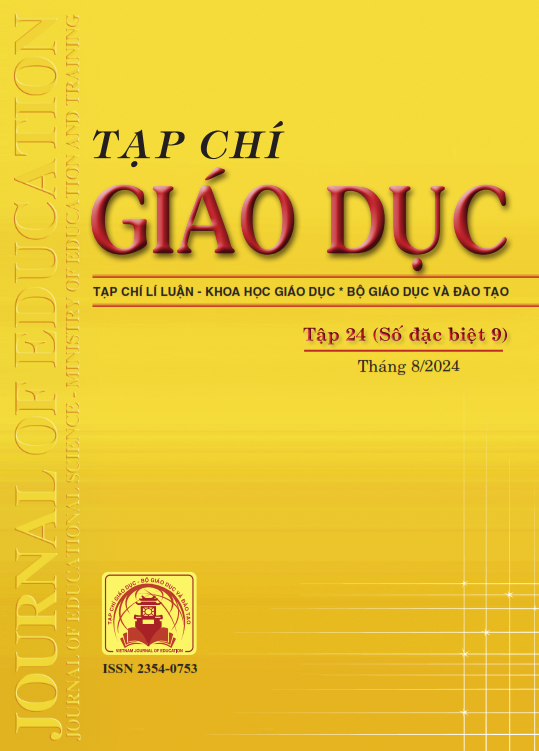Xây dựng bộ tiêu chí đánh giá "Hệ sinh thái học qua mạng" ở trường đại học
Tóm tắt
In the contemporary technological era, the advancement of online learning and the networked learning ecosystem has become an integral component of the university milieu. Harnessing information technology to provide adaptable and efficacious learning experiences is emerging as a predominant trend within the educational sphere. However, to ensure that this online learning system operates proficiently and yields tangible benefits for students, the establishment of a lucid and comprehensive set of evaluative criteria is paramount. This article will outline the process of developing evaluation criteria for the networked learning ecosystem at universities. Drawing on legal documents, we identify and develop evaluation criteria and seek input from experts to make appropriate improvements and guide future enhancements of the criteria. This set of criteria not only provides basic standards to evaluate the level of maturity of the system, but also provides specific guidance for improving and developing specific aspects of the online learning ecosystem.
Tài liệu tham khảo
Baker, B. D., Richards, C. E. (2003). The Ecology of Educational Systems: Data, Models, and Tools for Improvisational Leading and Learning. Pearson.
Bloom, B. S., Madaus, G. F., & Hastings, J. T. (1971). Handbook on Formative and Summative Evaluation of Student Learning. New York: McGraw-Hill.
Bộ GD-ĐT (2016). Thông tư số 04/2016/TT-BGDĐT ngày 14/3/2016 ban hành Quy định về tiêu chuẩn đánh giá chất lượng chương trình đào tạo các trình độ của giáo dục đại học.
Bộ GD-ĐT (2017). Thông tư số 10/2017/TT-BGDĐT của ngày 28/4/2017 ban hành Quy chế đào tạo từ xa trình độ đại học.
Bộ GD-ĐT (2020). Thông tư số 39/2020/TT-BGDĐT ngày 09/10/2020 quy định về tiêu chuẩn đánh giá chất lượng chương trình đào tạo từ xa trình độ đại học.
Carliner, S., & Shank, P. (2016). The E-learning Handbook: Past Promises, Present Challenges. Pfeiffer Publisher. Clark, R.C., & Mayer, R.E (2016). E-Learning and the Science of Intruction: Proven Guidelines for Consumers and Designers of Multimedia Learning. John Wiley & Sons.
Herrington, J., Reeves, T. C., & Oliver, R. (2009). A guide to Authentic E-Learning. Routledge.
Hoàng Phê (chủ biên, 2003). Từ điển tiếng Việt. NXB Đà Nẵng.
Johnson, S. (2015). Education and International competitiveness. Journal of Initial Teacher Inquiry, 1, 22-24.
Kuhs, T. K., Johnson, R. L., Susan A., & Diane, M. (2001). Guides to scoring student work: Checklist and Rubrics, Put to the Test: Tool and Techniques for Classroom Assessment. Heinemann Publication.
McMillan, J. H. (2014). Classroom Assessment: Principles and Practice for effective standards - based instruction. Pearson Education. Means, B., Toyama, Y., Murphy, R., Bakia, M., & Jones, K. (2010), Evaluation of Evidence-Based Practices in Online Learning: A Meta-analysis and Review of Online Learning Studies. US Department of Education.
Phillips, R., McNaught, C., & Kennedy, G (2011). Evaluating E-Learning Guiding Research and Practice. Routledge.
Renya, J. (2011). Digital Teaching and Learning Ecosystem (DTLE): A Theoretical Approach for Online Learning Environments. In G. Williams, P. Statham, N. Brown & B. Cleland (Eds.), Changing Demands, Changing Directions. Proceedings ascilite Hobart 2011 (pp.1083-1088).
Scriven, M. (1967). The Methodology of Evaluation. In R. W. Tyler, R. M. Gagne, & M. Scriven (Eds.). Perspectives of Curriculum Evaluation Chicago (pp. 39-83). Rand McNally.
Spencer-Keyse, J., Luksha, P., & Cubista, J. (2020), Learning Ecosystems: An Emerging Praxis for the future of Education. Published by Moscow School of Management SKOLKOVO & Global Education Futures.
Wiener, N. (1965). Cybernetics or control and communication in the animal and the machine. The MIT Press.
Wiggins, G., & Mctighe, J. (2012). Understanding by Design. ASCD Publication.
Tải xuống
Đã Xuất bản
Cách trích dẫn
Số
Chuyên mục
Giấy phép

Tác phẩm này được cấp phép theo Ghi nhận tác giả của Creative Commons Giấy phép quốc tế 4.0 .












